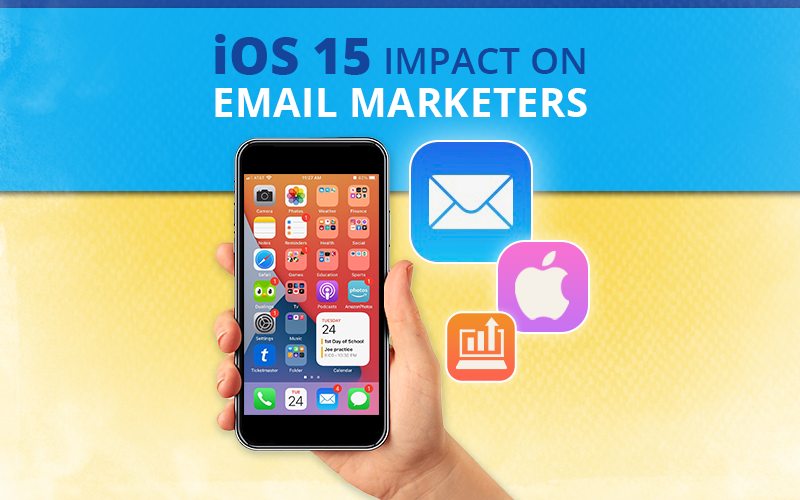If email open rate is one of your key metrics for your email program, get ready for a wild ride this fall when Apple releases iOS 15. Apple’s new Mail Privacy Protection feature will allow (encourage, really) Apple Mail users to “protect” their mail activity. Once Apple Mail users enable mail protection, Apple will pre-load all HTML email content on a proxy server whether readers open the emails or not.
This means that your open rates will probably be skewed high for Apple iOS users in the future. This impacts anyone who has Apple Mail users on their lists, which is, essentially, almost everyone! Litmus reported that the Apple Mail client represented over 49% of email opens as of July 31, 2021.
This will affect open rates for email subscribers who use the Apple Mail app on any device: desktop, tablet or phone. Note that this includes all email accounts viewed using Apple Mail. Many Apple users view their Gmail, Outlook, Microsoft Exchange, iCloud, Yahoo and AOL emails on the native Apple Mail app.
Mail Privacy Protection will also prevent marketers from tracking reader location (via IP) and device. In other words, for Apple Mail users, we won’t be able to see how much of our audience views emails on mobile vs. desktop devices, and further, we won’t know the breakdown by device anymore.
Apple typically releases new operating systems in September, so it’s important to carve out some time now to prepare for iOS 15.
What should you do?
- Prepare now to adjust your expectations for open rates as soon as mid-September, when Apple typically releases new operating systems. We recommend that, before then, you find out how many of your readers/subscribers use Apple Mail and adjust your metrics reporting accordingly. Litmus offers a formula you could use that takes into account how many Apple Mail users are expected to enable the Mail Privacy Protection feature and what the open rate for Apple Mail users is expected to be given the use of proxy servers.
- Review how you define inactive subscribers for reengagement campaigns or purging your list. If your criteria for inactives includes “has not opened an email in X months,” you will have far fewer email addresses meeting that criteria. “Last open date” also will no longer be an accurate measure of engagement for this strategy.
- Revise your list build process for campaigns that suppress inactive subscribers.
- Look at all automations that are triggered by an open. These will need to be adjusted.
- If you are using a send-time-optimization strategy based on open times, consider how iOS 15 will impact this as well.
- Rethink your A/B split testing strategy. Opens won’t be as helpful in determining the “winner” for an A/B split. One could argue that this isn’t the best metric anyway and that conversions, purchases, or even clicks provide a better measure for A/B split testing. Still, for the newsletters many of our clients send out, open rates have always been an important indicator of engagement.
- Consider what other metrics are available to you to measure campaign success. Clicks, conversions, purchases, subscriptions, downloads, calls, etc.
What about deliverability?
One of our biggest concerns with the Mail Privacy Protection release is the negative impact it may have on our ability to flag deliverability issues before they become problematic. Typically, observing a sudden dip in opens is the first red flag that a campaign might be blocked or landing in junk folders for some reason. Also, we know that mailbox providers use engagement (with opens being one key indicator) to decide which emails get blocked. It’s going to be a lot harder for mailbox providers to determine what to mark as spam.
Conclusion
It will take time to fully see how Apple’s Mail Privacy Protection feature will impact email marketing overall, but we know that email marketing has weathered many a technology storm. Remember when Outlook began blocking images by default and we had to adjust open rates accordingly because tracking pixels didn’t load? How about Gmail’s “Promotions” tab? Some people thought no one would ever look there and retail brands were doomed. We will get through this storm, too.
Anything that is good for consumers should ultimately help us all be better marketers.
Helpful Resources:
- Litmus: Apple’s Mail Privacy Protection: What This Means for Email Marketers and How To Prepare Now
https://www.litmus.com/blog/apple-mail-privacy-protection-for-marketers - Litmus: The Mail Privacy Protection Survival Guide for Marketers
https://www.litmus.com/resources/mail-privacy-protection-guide - Adestra: What Your Company Needs to Know About iOS 15
https://uplandsoftware.com/resources/article/faq-what-your-company-needs-to-know-about-ios-15/ - Cordial: Are You iOS 15 Ready?
https://cordial.com/resources/are-you-ios-15-ready - Only Influencers: The 2 Social Contracts Being Broken by Apple’s New Privacy Protections
https://onlyinfluencers.com/email-marketing-blog-posts/best-practice-email-strategy/entry/the-2-social-contracts-being-broken-by-apple-s-new-privacy-protections - Forbes: Apple’s Mail Privacy Protection Will Force Marketers To Innovate Beyond the Open
https://www.forbes.com/sites/forbesbusinesscouncil/2021/07/19/apples-mail-privacy-protection-will-force-marketers-to-innovate-beyond-the-open/?sh=71a2d2caa129
Need help preparing for iOS 15? Contact the Katey Charles Communications team to set up a consultation.

